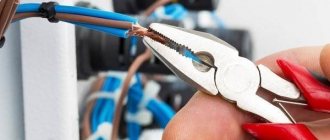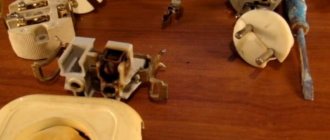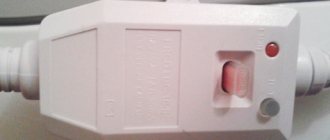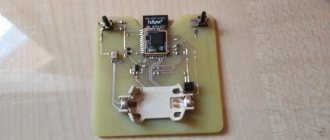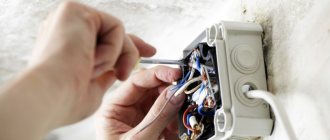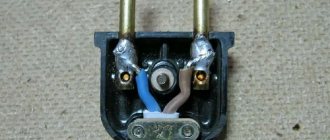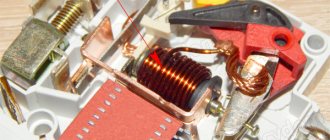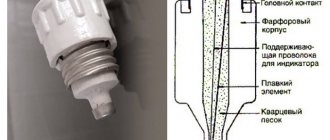Faulty plug
There is no point in delaying repairs - the socket may spark and an unpleasant burning smell will appear. In addition to equipment failure, it is simply dangerous, for example due to the risk of fire or electric shock. It is necessary to limit the use of sockets and plugs, or better yet, stop.
If smoke or other serious signs appear, turn off the electricity. Usually the switch is located in the meter on the distribution panel. You need to hire a specialist or fix it yourself. Work is carried out after a power outage.
There may be several reasons for heating. First of all, you need to check the plug. It is inserted into a working socket. The load is given: the device turns on. You need to wait 5 - 15 minutes and assess the condition. If the plug gets hot, that means it's the problem. If not, you need to look further for the reason.
If the plug breaks, you can replace it or try to repair it.
There are two types of plug design:
- The body is sealed. You can only install a new plug. The wire from the old one is carefully cut off, the ends are stripped, and another plug is connected.
- Collapsible - it becomes possible to eliminate a specific malfunction and repair the plug.
Solving problems with a collapsible fork
We check the reliability of the connection between the legs of the plug and the ends of the wires.
Contact is broken for the following reasons:
- Weak bolt fastening. You just need to tighten it all the way.
- Burnt wiring. The damaged area is cut off, a new fastening is made: the insulation is removed, the wire is stripped, and connected with a bolt.
- Oxidation can be eliminated in one of the following ways: by cleaning with a knife or sandpaper, using acid for etching, simply cutting off the damaged area and assembling a new contact.
Reasons related to the fork
Common reasons why the plug in the socket heats up:
- Poor contact between socket and plug. The connection must be without gaps. The diameters of the plug legs and the socket holes must match. To check, slightly rock the inserted plug. If there is noticeable play, the socket must be replaced.
- The use of tees and adapters that may not be designed for such a load. The parameters are clarified with the seller or in the documents. For security reasons, it is better not to use “intermediaries” to connect powerful devices.
- Connecting equipment with plug contacts of different diameters to the socket, for example, a water heater and a hair dryer.
Useful video
To find out the specific reason why the socket and plug are heating up, determine which component is to blame. Connect the problematic plug to another terminal. Wait and watch for about 10 minutes.
The problem is the plug
If the connection you are testing becomes hot again, you can be sure that the plug itself is faulty. It is he who needs repair or replacement.
- In a removable plug, the screws securing the wires to the contacts may become loose. Disassemble the device, repair it.
- The molded plug is integral with the electrical cord. Therefore, cut off the plug and install a new one.
- In an older product, the diameter of the plug pins is smaller than the socket holes. Consequently, they are not installed tightly when connected, which provokes heating. This plug should be replaced with a new one.
Expert opinion
It-Technology, Electrical power and electronics specialist
Ask questions to the “Specialist for modernization of energy generation systems”
Why do we need sockets with a thermostat for heaters? Melting and heating of the plug is difficult not to notice; as a rule, during this process the plastic plug slowly heats up, which provokes the formation of a burning smell. Ask, I'm in touch!
Why does the plug in the socket heat up: wiring faults, elimination of heating
The plug combined with the socket is a quick-release contact connection. In this way, almost any modern equipment can be connected to the network. This method is reliable, simple and convenient if all components of the system are in working order. Otherwise, the plug in the socket gets hot or other problems occur.
Load determination using wire cross-section
Table for selecting cable cross-section depending on the load
To check the wiring capabilities and determine the maximum load for a specific electrical network, you need to find out the cross-sectional area of the wire and perform calculations:
- First, you should determine the diameter of the core using a caliper. The actual cross-sectional area is found using the formula: Sф.=0.785*D2. Instead of “D”, substitute the measurement result.
- To calculate the specific current and power, you must find the difference between the maximum and minimum values in the interval in which the calculated cross-sectional area falls. The difference in specific current strength is divided by the difference in cross sections in the same interval, where the smaller value is index 1, and the larger value is index 2, namely Isp. = (I2-I1)/(S2/S1). The value is obtained in A/mm2. Specific power is found in a similar way: Nsp.=(N2-N1)/(S2/S1). The required current and power values are calculated using the formulas: Isq.=(Sph.-S1)*Isp.+I1 and Nsq.=(Sph.-S1)*Nsp.+N1.
If the values obtained in the calculations are less than those indicated in the instructions for electrical appliances, the cause of heating is weak electrical wiring.
Why does the wire in electrical appliances and extension cords get hot?
Heating of the wire in electrical appliances is caused by a disproportionate ratio of the cross-section of the wire and the strength of the current that flows through it. If the wire is thin and the appliance is powerful, for example an electric kettle or electric heater, the thin wires will heat up. The same thing happens if a device with a cable of sufficient diameter is connected to an outlet using a household extension cord.
The socket on the washing machine gets hot
If the socket is frequently removed and plugged in, the connectors quickly become damaged.
If the outlet into which the washing machine is connected heats up, this phenomenon may be caused by the following reasons:
- Disproportionate power of the machine connected to the outlet - on the body of the outlet it is indicated what power it is designed for. If the numbers don't match, it will inevitably cause overheating.
- Poor contact between the plug and the socket is observed when connecting a Soviet-style plug to a European socket. The electrodes of the Soviet plug are a millimeter thinner, and therefore the contact density is less.
- The socket itself is faulty. Visually it can be diagnosed by the presence of cracks and melted areas.
- Weak socket contact blades. Due to careless use, the clamps may become loose.
None of these reasons will go away on their own. Measures should be taken to eliminate it.
The water heater plug is getting hot
It is not advisable to use adapters
A water heater is a powerful device. A boiler, for example, has a power of 1.5 to 2.5 kW, and its amperage reaches 12 A. If the plug, socket or cable becomes so hot that it is impossible to touch it, the possible reasons are the following:
- the cable has a cross-section of less than 2.5 mm2;
- there is poor contact of the plug in the socket;
- the water heater is connected via an extension cord;
- A low-quality or old-style socket is installed.
Heating of the boiler plug is acceptable, but the temperature must be within normal limits. A hot, but not scalding body without any traces of melting is not a cause for concern.
Why does the outlet get hot?
Secrets of handling equipment
Heating of the plug of a household electrical appliance or socket is evidence of serious problems, which must be eliminated as soon as possible.
Overloaded socket
When you discover that an electrical outlet or plug in a household appliance has begun to heat up, the first thing to do is compare the load on the outlet and its technical characteristics.
You won’t have to look for them for long; on each socket the manufacturer provides information about the maximum permissible voltage and current values.
The inscription “6A 220V” will indicate that the power of the electrical device plugged into the outlet should not exceed 1.3 kW (6A x 220V).
If a heater with a power of one and a half kilowatts is plugged into such an outlet, then it is not surprising that the outlet will heat up, since it will work beyond its capabilities.
A socket rated “10A 220V” is designed for continuous operation with a consumer power of no more than 2.2 kV (10A x 220V), and the maximum power of a device that can be powered without consequences from a socket marked “16A 220V” is 3.5 kW ( 16A x 220V).
There are two ways out of this situation: either use/install an outlet with a higher rating, or monitor the total power of the devices included in it.
Plug fault
If the outlet rating allows the use of an electrical appliance of a certain power, but the plug in the outlet still gets hot, plug the device into a different outlet. Reheating the fork will unmistakably indicate that the problem lies in the fork itself.
Troubleshooting methods depend on the plug form factor. For a collapsible plug, check that the wires are securely attached to the contacts and, if necessary, tighten the fastening screws.
If the ends of the wires are oxidized or burnt, cut the end of the connecting cable, remove the insulation from the ends of the conductors and re-install the contact groups.
Rarely, but still there are plugs of the “Soviet” type, the thickness of the contact pins of which is much less than that of modern plugs. This type of plug does not fit tightly into the socket, so the best way out of this situation is to replace it with a new, modern model.
Socket problems
If the outlet gets hot no matter what device is plugged into it, that is the cause of the malfunction.
Before starting work, be sure to turn off the power to the apartment!
Unscrew the screw and remove the cover from the socket. To diagnose the socket, loosen the bolts of the fastening tabs (if the socket is built-in) or unscrew the fastening screws (if the socket is surface-mounted). Slightly bend the wire, move the socket away from the wall and begin inspection.
First of all, check the fastening of the wires supplying power to the outlet. If the wiring is made of wire with copper cores, tighten the clamp bolts with a screwdriver.
If the socket is powered by aluminum wires, remove their ends from the contact clamps and carefully examine them. Bite off the burnt, crumbled and melted ends of the wires, remove the insulation from them, insert them into the clamps and tighten the fastening screws thoroughly.
After a month or two, be sure to return to this outlet and tighten the clamp screws. Due to the softness of aluminum, the ends of the wires fixed with clamps can change their shape (as electricians say, “aluminum flows”), as a result, the contact in the socket will inevitably weaken.
Check the contact plates and contact springs. If necessary, bend them or replace them with new ones.
Pay close attention to the parts of the socket body: if they are cracked, charred or melted, the socket must be replaced with a new one. What should you do if the outlet heats up and nothing is plugged into it? Yes, this happens too
And only if another outlet is powered from it
What should you do if the outlet heats up and nothing is plugged into it? Yes, this happens too. And only if another outlet is powered from it.
If the technical condition of the pass-through socket is poor, it will heat up. It is for this reason that each outlet must be connected with a separate conductor to the distribution box.
Check the condition of the heated feed-through socket, tighten the contacts, eliminate defects, or even better, replace it with a new one.
Source
How to prevent critical heating of the zero?
Since on the scale of an apartment the influence of higher harmonics is insignificant, we will immediately move on to the problem of poor electrical contacts. If you find a problem area in the apartment panel where the electrical connection is heating up, then first of all turn off the input circuit breaker and make sure that after that the current does not flow. The best way to test is to use a combination of a voltage probe and a multimeter set to AC current.
Once you are sure the power is off, loosen the offending terminal (usually a screw terminal) to remove the wire. Clean it, as well as the clamp. If the panel wiring is made with stranded copper wire, then its ends must be tinned or crimped. After this, you can collect the contact. It should be taken into account that “pinching” the wire with a screw connection is as undesirable as a weak clamp.
Direct contact of copper and aluminum is unacceptable, since these materials form a galvanic couple, as a result of which the electrical resistance of such a connection will increase quite quickly.
If the installation was carried out using thin wires, then it is advisable to replace them. How to choose the right cross section depending on the load current is described on our website.
Phase imbalance protection
The best option for this case is to install a voltage relay.
Voltage relay
This device will provide protection against both voltage drops and excessive increases. As an alternative solution, we can suggest installing a stabilizer for the entire apartment. Despite the higher cost, the advantages are obvious - “sag” or overvoltage will not cause a power outage.
Dangerous cable: why electrical wires get hot
Heating of electrical wires is a dangerous phenomenon, which can cause the protective insulation to melt and cause the electrical wiring to ignite.
Main reasons for heating:
- The wiring is not installed correctly;
- Poor twisting of wires;
- Poor cable quality;
- Inability of the cable to withstand the load.
In most cases, wires heat up if the cross-section is incorrectly selected. They cannot withstand the modern load of household appliances. It is necessary to limit the number of simultaneous connections of several devices or completely replace the wiring with modern materials.
The cable in the apartment must have a cross-section of at least 2.5 square meters. mm for connecting to sockets, and 1.5 sq. mm for lighting.
If the old wiring was equipped with a copper cable, then the aluminum wire must be connected through special terminal blocks. Aluminum and copper have different electrical conductivities and should not come into contact, otherwise heating of the cable cannot be avoided.
If the wiring in the house heats up, melts and flares up, you must urgently take the following steps:
- Disconnect the apartment;
- Cut the wire with a tool with wooden handles;
- Cover the flame with a rag.
If you are unable to extinguish the flame yourself, immediately call the fire department.
How to fix the network connection point
Heating of the device, a burning smell, and the appearance of sparks even under normal load indicate that the device should be disassembled to determine the cause of the malfunction. And then the cause must be eliminated.
Turn off the electricity supplied to the suspicious connection point. This can be done by turning the handle of an old bag, unscrewing the plugs, or using automatic fuses. Check the presence of voltage in the network after disconnection. Use an indicator screwdriver or a work desk lamp. After making sure that the light does not come on, proceed to disassembly. Remove the cover from the device. Loosen the screws of the tabs that secure the operating mechanism in the socket
Carefully remove the interior and wires for further analysis.
When inspecting the device, the following faults are most often found:
- The clamping of the power supply cores that connect the distribution mechanism to the wiring in the room has become loose. This damage is more common with soft aluminum conductors. Their ends should be inspected and crumbled parts should be removed. Remove insulation from about 9 mm of the entire wire. Secure them with clamps and assemble the socket. If the wires are copper, you need to tighten the clamp screws using a screwdriver.
- Deformation of the contact plates located in the device sockets. It is a consequence of plastic melting when the load is exceeded. A socket with such a breakdown must be replaced.
- If the device is a pass-through device (that is, the next one comes from it), then even without the plug on it can heat up. The product should be disassembled and the clamps and plates checked. After correction, assemble and check the quality of work.
The plug in the socket gets hot
» Sockets » Why does the socket on the washing machine get hot?
Why does the socket on the washing machine get hot?
31.08.2015
In order to prevent short circuits, burnt wires and thereby prevent damage to household electrical appliances, it is necessary to regularly check the condition of the sockets. After all, it is always easier and cheaper to prevent a minor breakdown than to later pay for your sluggishness not only with money, but possibly with your health.
If the outlet is heating up, then you should not hope that the reason for this will simply disappear, without outside intervention.
Heating of the outlet can be caused by various reasons, including:
- Excessive power of electrical appliances connected to the outlet.
- Unstable contact of the plug inside the socket.
- Malfunction of the connectors inside the socket.
- The contact of the socket clamp is not tight enough.
What is the reason
In most cases, sockets burn out due to multiple excess power of various electrical appliances that are connected to it.
You should know that on the body of any outlet there is relevant information in numbers that helps solve the problem before it occurs.
You just need to know the power of electrical appliances connected to the network and compare these numbers with those indicated on the outlet.
Often, the reason for an insecure connection between the socket and the plug is the unsatisfactory fixation of the plug with the connectors inside the socket. Old-style plugs from the times of the USSR are still very common, but their electrodes are almost a millimeter thinner than the electrodes of modern sockets, and the electrodes themselves are located at the same distance on both types of sockets.
The plug must be compatible
You need to be careful and not try to connect a Soviet plug into a modern socket: this will certainly cause it to heat up, due to the guaranteed weak contact with the connectors inside the socket.
If the socket is subjected to frequent mechanical stress, that is, the plug is often removed and inserted, then the socket connectors quickly fail and cannot sufficiently fix the electrodes. This also causes the outlet to heat up.
Probably the best wire material to use for wiring is copper rather than aluminum. And the point here is not electrical conductivity or resistance difference. The fact is that aluminum has one drawback: it is very plastic and, over time, tends to leak out from under the contact clamps. This weakens the screw clamp and inevitably causes the socket to heat up.
